Posted on February 21st, 2014 by Mary Lord
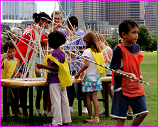 Developed by the Museum of Science, Boston, Engineering Everywhere is a free engineering curriculum full of hands-on design activities for middle-school-aged youth in after-school and camp programs.
Developed by the Museum of Science, Boston, Engineering Everywhere is a free engineering curriculum full of hands-on design activities for middle-school-aged youth in after-school and camp programs.
Read More
Filed under: Class Activities, Grades 6-8, Grades 6-8, Grades 6-8, K-12 Outreach Programs, Lesson Plans, Web Resources | Comments Off on Engineering Everywhere
Tags: After School, Boston Museum of Science, Curriculum, Engineering Everywhere, Engineering is Elementary, Environmental Engineering, process engineering, Resources for Teachers, STEM education
Posted on January 20th, 2014 by Mary Lord
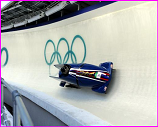 Teams of students in grades 3 to 8 learn about friction, forces, and the engineering design process by building and testing miniature bobsleds to see which can race down an icy slope either the fastest or slowest.
Teams of students in grades 3 to 8 learn about friction, forces, and the engineering design process by building and testing miniature bobsleds to see which can race down an icy slope either the fastest or slowest.
Read More
Filed under: Class Activities, Grades 6-8, Grades 6-8, Grades K-5, Grades K-5, Lesson Plans | Comments Off on Build a Bobsled Racer
Tags: Aerodynamics, Bobsled, Boston Museum of Science, Energy, Engineering Design Process, friction, glide, kinetic energy, Olympics
Posted on December 20th, 2013 by Mary Lord
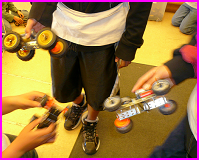 In this hands-on activity, student teams apply the engineering design process to create prototype toys with moving parts. They set up electric circuits using batteries, wire, and motors, and plan project materials to meet budget constraints.
In this hands-on activity, student teams apply the engineering design process to create prototype toys with moving parts. They set up electric circuits using batteries, wire, and motors, and plan project materials to meet budget constraints.
Read More
Filed under: Class Activities, Grades K-5, Grades K-5, Lesson Plans | Comments Off on Build-a-Toy Workshop
Tags: Class Activities, Design, Electrical Engineering, Engineering Design, Grades K-5, Lesson Plans, Mechanical engineering, toys
Posted on November 27th, 2013 by Mary Lord
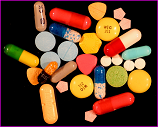 Student teams in grades 6-8 reinforce their knowledge of the digestive system and explore the concepts of simulation and the engineering design process by developing a pill coating that can withstand the churning and acidic environment of the stomach. They test the coating’s durability using a clear soda to simulate gastric acid.
Student teams in grades 6-8 reinforce their knowledge of the digestive system and explore the concepts of simulation and the engineering design process by developing a pill coating that can withstand the churning and acidic environment of the stomach. They test the coating’s durability using a clear soda to simulate gastric acid.
Read More
Filed under: Class Activities, Grades 6-8, Grades 6-8, Lesson Plans | 2 Comments »
Tags: Biology, Biomedical, Chemical Engineering, Class Activities, coating, digestion, Grades 6-8, Human Body, Lesson Plan, Manufacturing Engineering, Materials Engineering, medicine, pill
Posted on October 24th, 2013 by Mary Lord
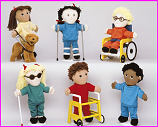 Students in grades 6 to 8 gain an understanding of physical limitations and the biomedical engineering design process by performing a variety of tasks without using their thumbs, eyes, or legs, then working in teams to create or improve and adaptive device.
Students in grades 6 to 8 gain an understanding of physical limitations and the biomedical engineering design process by performing a variety of tasks without using their thumbs, eyes, or legs, then working in teams to create or improve and adaptive device.
Read More
Filed under: Class Activities, Grades 6-8, Grades 6-8, Grades 9-12, Grades 9-12, Lesson Plans | Comments Off on Seeing the World Through a Different Lens
Tags: adaptive technologies, assistive technologies, bioengineering, biomechanical engineering, Class Activities, Grades 6-8, Lesson Plan, Mechanical engineering, Prosthetics, students with disabilities
Posted on September 25th, 2013 by Mary Lord
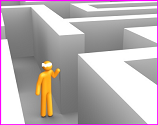 In this activity, students working in pairs learn basic computer programming and software engineering concepts by building an obstacle course, then steering a blindfolded friend through it by using a series of commands. They re-run the maze to improve on their “program.”
In this activity, students working in pairs learn basic computer programming and software engineering concepts by building an obstacle course, then steering a blindfolded friend through it by using a series of commands. They re-run the maze to improve on their “program.”
Read More
Filed under: Class Activities, Grades 6-8, Grades 6-8, Grades K-5, Grades K-5, Lesson Plans | Comments Off on Program a Friend
Tags: Class Activities, coding, Computer Programming, Grades 6-8, Grades K-5, Lesson Plans, Mathematics, Robotics, software engineering, Technology
Posted on August 29th, 2013 by Mary Lord
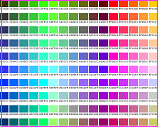 Computer science has the highest pay for new college graduates, twice the national average job growth of more than double the national average, and applications that stretch from rock music to medicine. Yet 9 in 10 schools don’t teach programming. Code.org hopes to change that with a host of free resources to get kids as young as four creating websites and apps.
Computer science has the highest pay for new college graduates, twice the national average job growth of more than double the national average, and applications that stretch from rock music to medicine. Yet 9 in 10 schools don’t teach programming. Code.org hopes to change that with a host of free resources to get kids as young as four creating websites and apps.
The answer is computer programming, and advocates from Microsoft founder Bill Gates to former president Bill Clinton are pushing to include it in the K-12 curriculum.
Far from being complicated algorithms only a geek could master, code writing can be learned by just about anyone — even four-year-olds. Code.org has compiled a host of websites, courses, and other free resources to help students hone programming skills from building websites to creating phone apps. There also are tips for using code writing and programming projects and activities in math or science classes to cover content standards.
Read More
Filed under: For Teachers, Grades 6-8, Grades 6-8, Grades 9-12, Grades 9-12, Grades K-5, Grades K-5, K-12 Outreach Programs, Lesson Plans, Special Features, Web Resources | Comments Off on Code Calling
Tags: code writing, code.org, Computer Programming, Computer Science, Curriculum, Internet Resources, Lesson Plan, Resources for Teachers, STEM education, Teacher Resources, Technology for Learning, Website
Posted on July 31st, 2013 by Mary Lord
 In this first of eight activities, students in grades 6 – 8 learn about the engineering design process and earth science by beginning to design an underground cavern that can shelter people for one year after an asteroid strike makes Earth uninhabitable.
In this first of eight activities, students in grades 6 – 8 learn about the engineering design process and earth science by beginning to design an underground cavern that can shelter people for one year after an asteroid strike makes Earth uninhabitable.
Read More
Filed under: Class Activities, Grades 6-8, Grades 6-8, Lesson Plans | Comments Off on Asteroid Impact!
Tags: asteroid, Class Activities, Common Core State Mathematics Standards, Disaster relief, Earth Science, Engineering Design, Geology, Grades 6-8, ITEEA, Lesson Plans, Next Generation Science Standards, shelter, Space
Posted on June 19th, 2013 by Mary Lord
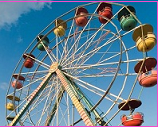 In this activity, teams of students in grades K-12 learn about the history and engineering behind Ferris wheels by constructing a working model using pasta, glue, and teabags.
In this activity, teams of students in grades K-12 learn about the history and engineering behind Ferris wheels by constructing a working model using pasta, glue, and teabags.
Read More
Filed under: Class Activities, Grades 6-8, Grades 6-8, Grades 9-12, Grades 9-12, Grades K-5, Grades K-5, Lesson Plans | Comments Off on Build a Big Wheel
Tags: Class Activities, Ferris wheel, Grades 6-8, Grades 9-12, Grades K-5, London eye, motions and forces, Physics
 Developed by the Museum of Science, Boston, Engineering Everywhere is a free engineering curriculum full of hands-on design activities for middle-school-aged youth in after-school and camp programs.
Developed by the Museum of Science, Boston, Engineering Everywhere is a free engineering curriculum full of hands-on design activities for middle-school-aged youth in after-school and camp programs.








 Teams of students in grades 3 to 8 learn about friction, forces, and the engineering design process by building and testing miniature bobsleds to see which can race down an icy slope either the fastest or slowest.
Teams of students in grades 3 to 8 learn about friction, forces, and the engineering design process by building and testing miniature bobsleds to see which can race down an icy slope either the fastest or slowest. In this hands-on activity, student teams apply the engineering design process to create prototype toys with moving parts. They set up electric circuits using batteries, wire, and motors, and plan project materials to meet budget constraints.
In this hands-on activity, student teams apply the engineering design process to create prototype toys with moving parts. They set up electric circuits using batteries, wire, and motors, and plan project materials to meet budget constraints. Student teams in grades 6-8 reinforce their knowledge of the digestive system and explore the concepts of simulation and the engineering design process by developing a pill coating that can withstand the churning and acidic environment of the stomach. They test the coating’s durability using a clear soda to simulate gastric acid.
Student teams in grades 6-8 reinforce their knowledge of the digestive system and explore the concepts of simulation and the engineering design process by developing a pill coating that can withstand the churning and acidic environment of the stomach. They test the coating’s durability using a clear soda to simulate gastric acid. Students in grades 6 to 8 gain an understanding of physical limitations and the biomedical engineering design process by performing a variety of tasks without using their thumbs, eyes, or legs, then working in teams to create or improve and adaptive device.
Students in grades 6 to 8 gain an understanding of physical limitations and the biomedical engineering design process by performing a variety of tasks without using their thumbs, eyes, or legs, then working in teams to create or improve and adaptive device. In this activity, students working in pairs learn basic computer programming and software engineering concepts by building an obstacle course, then steering a blindfolded friend through it by using a series of commands. They re-run the maze to improve on their “program.”
In this activity, students working in pairs learn basic computer programming and software engineering concepts by building an obstacle course, then steering a blindfolded friend through it by using a series of commands. They re-run the maze to improve on their “program.” Computer science has the highest pay for new college graduates, twice the national average job growth of more than double the national average, and applications that stretch from rock music to medicine. Yet 9 in 10 schools don’t teach programming. Code.org hopes to change that with a host of free resources to get kids as young as four creating websites and apps.
Computer science has the highest pay for new college graduates, twice the national average job growth of more than double the national average, and applications that stretch from rock music to medicine. Yet 9 in 10 schools don’t teach programming. Code.org hopes to change that with a host of free resources to get kids as young as four creating websites and apps. In this first of eight activities, students in grades 6 – 8 learn about the engineering design process and earth science by beginning to design an underground cavern that can shelter people for one year after an asteroid strike makes Earth uninhabitable.
In this first of eight activities, students in grades 6 – 8 learn about the engineering design process and earth science by beginning to design an underground cavern that can shelter people for one year after an asteroid strike makes Earth uninhabitable. In this activity, teams of students in grades K-12 learn about the history and engineering behind Ferris wheels by constructing a working model using pasta, glue, and teabags.
In this activity, teams of students in grades K-12 learn about the history and engineering behind Ferris wheels by constructing a working model using pasta, glue, and teabags.